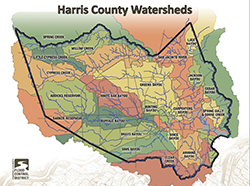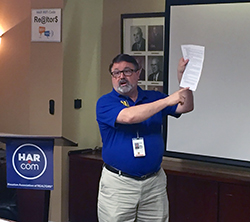Governmental Affairs Advisory Group Volunteers Receive Briefing on Tax Day Flood Impact for Greater Houston Area and Brainstorm Future Mitigation Plans
Last month, more than 20 REALTOR® volunteers met with various stakeholders across multiple levels of government to discuss the current status of the region in regards to flood recovery. Additional discussion was held to determine the development of long-term flood mitigation solutions.
REALTORS® needed to be a part of the conversation to speak on behalf of homeowners and business owners. It has only been a few weeks since the 2016 Tax Day flood struck the Greater Houston area. The April 18 floods had a dramatic impact on our entire region. More than 3,700 homes were damaged in Harris County, with some flooding for the second, third or fourth time.
The City of Houston’s new Director of Government Relations Bill Kelly provided a summary presentation on the City of Houston’s actions in response to the April 18th rain event. He assured the group that the City is coordinating with multiple stakeholders and now, under the new leadership of recently appointed “flood czar,” former city councilmember Steve Costello will lead the charge of planning the City’s future flood mitigation efforts. Costello will report directly to the mayor and will have the sole responsibility of developing and implementing strategies that will improve drainage and reduce the risk of flooding.

GAAG Co-Chairs Ray Wade and Ed Wolff pictured here with representatives from the Federal Emergency Management Agency, U.S. Small Business Administration, Harris County Engineer John Blount, Harris County Flood Control District Executive Director Mike Talbott and City of Houston Director of Government Relations Bill Kelly.
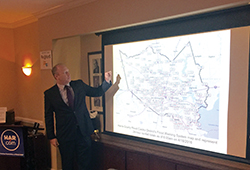
City of Houston Director of Government Relations Bill Kelly showing the 24-hour rainfall totals per data given from the Harris County Flood Control District’s map on Monday, April 18, 2016.
Harris County Engineer John Blount was next on the agenda and provided a status report on the county’s flood mitigation efforts. A call center was established within 72 hours of the flood. There were 3,710 damaged structures throughout the county: 2,348 were outside the floodplain (free, general permits were mailed within 4 hours of Harris County Commissioners Court authorization) and 1,362 homes within the 100 year floodplain required in-home substantial damage inspections. These inspections were at a 90% completion rate as of May 6. One of the biggest concerns raised by Mr. Blount was that a large number of homeowners in Harris County do not have flood insurance through the National Flood Insurance Program (NFIP). On average in the United States, less than 36% of those that should have National Flood Insurance Program insurance carry it through five years after their home purchase. Many homeowners believe that if their house is not in a floodplain, they do not need to buy flood insurance. In fact, 63.3% of houses that flooded in the Tax Day disaster were outside the 100 year floodplain. The bottom line is if you live in Harris County, you need flood insurance. Mr. Blount finished his presentation by leaving the REALTORS® with this charge: they need to educate, inform and advise their clients and colleagues on the importance of having flood insurance when purchasing a new home.
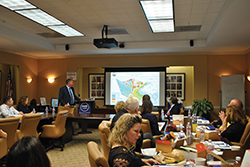
Harris County Engineer John Blount showing the 12 hour peak rainfall frequency during the April 18 flood event at the May 6 GAAG meeting
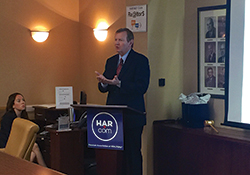
Mr. Talbott urged his City and County counterparts to continue working together in order to accomplish an overall flood mitigation strategy for the region.
Harris County Flood Control District Executive Director Mike Talbott gave the group an evaluation of community flood standards and how to best understand our region’s flooding patterns. He presented information on the area’s natural channels, natural floodplains, and the total drainage network. The evolution of community standards provided a historical background on how floodplain maps are seen today.
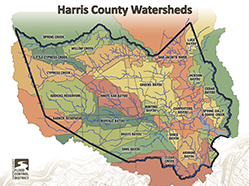
Harris County Flood Control District Map of area Watersheds, which is where land separates waters flowing to different rivers and basins.
Representatives from the Federal Emergency Management Agency (FEMA) and the U.S. Small Business Administration (SBA) presented information on disaster recovery. These individuals included: Paul Timmons with FEMA Individual Assistance; Pedro Perez with FEMA Floodplain Mitigation; Jerry Frye with the National Flood Insurance Program; Sharon Karr, FEMA Public Information Officer; and Garth MacDonald, SBA Public Information Officer with the Office of Disaster Assistance). Mr. Timmons provided an overview of the efforts FEMA has made with the City of Houston and Harris County in regards to their response to the Tax Day flood event. Within two weeks the agency opened up four fixed Disaster Recovery Centers (DRCs) to help homeowners, renters and businesses who suffered losses during the flood register for federal assistance. Specialists at these DRCs can provide guidance regarding disaster recovery and rental resources, explain written correspondence received from FEMA, inform survivors of the status of their application, make referrals to other organizations and answer questions. The fixed DRCs are located at:
- Bayland Community Center, 6400 Bissonnet St., Houston, TX 77074
- Greenspoint Commercial Office Building, 16800 Imperial Valley Dr., Houston, TX 77060
- Cypress Creek Christian Church and Community Center, 6823 Cypresswood Dr., Spring, TX 77379
- Lone Star College Cy-Fair Library, 9191 Barker Cypress Rd., Cypress, TX 77433
Hours at the centers are from 9 a.m. to 6 p.m. Monday through Friday; 9 a.m. to 2 p.m. on Saturdays and closed on Sundays until further notice. Survivors can also apply online at DisasterAssistance.gov or by phone (voice, 711 or relay service) at 800-621-3362. TTY users should call 800-462-7585. The toll-free lines are open 7 a.m. to 10 p.m. seven days a week. Applicants will be asked to provide:
- Social Security number
- Address of the damaged primary residence
- Description of the damage
- Information about insurance coverage
- A current contact telephone number
- An address where they can receive mail
- Bank account and routing numbers for those preferring direct deposit of funds
Eligible survivors should register with FEMA even if they have insurance. FEMA cannot duplicate insurance payments, but under-insured applicants may receive help after their insurance claims have been settled.
Federal assistance for affected individuals and families can include:
- Rental payments for temporary housing for those whose homes are unlivable. Initial assistance may be provided for up to three months for homeowners and at least one month for renters. Assistance may be extended if requested.
- Grants for home repairs and replacement of essential household items not covered by insurance to make damaged dwellings safe, sanitary and functional.
- Grants to replace personal property and help meet medical, dental, funeral, transportation and other serious disaster-related needs not covered by insurance or other federal, state and charitable aid programs.
- Unemployment payments up to 26 weeks for workers who temporarily lost jobs because of the disaster and who do not qualify for state benefits, such as self-employed individuals.
- Low-interest loans to cover residential losses not fully compensated by insurance. Loans available up to $200,000 for primary residence; $40,000 for personal property, including renter losses. Loans available up to $2 million for business property losses not fully compensated by insurance.
- Loans up to $2 million for small businesses, small agriculture cooperatives and most private, non-profit organizations of all sizes that have suffered disaster-related cash flow problems and need funds for working capital to recover from the disaster’s adverse economic impact. This loan in combination with a property loss loan cannot exceed a total of $2 million.
- Loans up to $500,000 for farmers, ranchers and aquaculture operators to cover production and property losses, excluding primary residence.
- Other relief programs: Crisis counseling for those traumatized by the disaster; income tax assistance for filing casualty losses; advisory assistance for legal, veterans’ benefits and social security matters.
The Governmental Affairs Advisory Group volunteers took this valuable information with them after the meeting and can now inform their clients and colleagues on how to better prepare for the next flood event. The briefing also gave some of the presenters who truly are working to resolve the flooding issues in Harris County an opportunity to meet each other for the first time. It is not a matter of if but when Mother Nature will hit next. REALTORS® have the tools to be resources in the community and need to be at the table with stakeholders when it comes to addressing the needs of homeowners.

